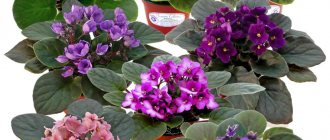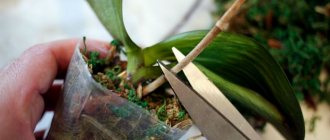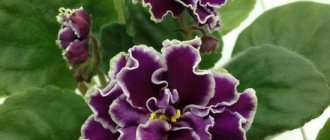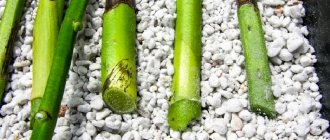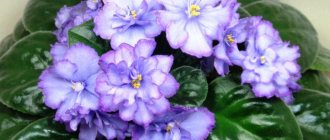Now Saintpaulia can be found in many homes ; it has become a common indoor plant. But this flower appeared in greenhouses in Europe only in the second half of the 19th century.
In the Soviet Union, selection of Uzambara violets has been carried out since the mid-20th century.
The generic name Saintpaulia was formed in honor of the discoverer of the flower -
Baron Saint-Paul , the German governor in East Africa. It was there, in the region of the Uzambara Mountains, that the baron found delicate flowers, so similar to ordinary European violets.
Violet PT-Angelica (T. Pugacheva)
Funny violet PT-Angelica.
Genus, family
The PT-Angelica variety belongs to the botanical species Uzambara violet.
Systematic position of the species:
- Family Gesneriaceae – Gesneriaceae;
- Genus Saintpaulia hybrid – Hybrid Saintpaulia;
- Species African violet saintpaulia hybrid.
History of the variety
The PT-Angelika variety was bred by the wonderful Kursk breeder Tatyana Pugacheva . Tatyana varieties are characterized by:
- Long cap flowering;
- Large corollas of violets;
- Dense, stable peduncles and petioles.
Photo and description of the variety
Uzambara violet variety Angelica blooms with large double flowers of deep pink color . Along the corrugated edge of the petals there is a two-color crimson-white border.
The petals have rare blue spots . The variety forms a large spreading rosette. Leaf blades:
- Bright green;
- Round-ovoid.
The edge of the leaf is crenate. The variety blooms for 3-4 weeks .
The variety has pink flowers.
Variegation, imprints
color :
- Uniform;
- Dark green.
Printings are not typical for the variety.
Sports
Angelica's sport is different:
- Lighter color of petals;
- And the absence of blue specks.
Violet has a lighter sport.
Violets, domestic varieties
Violets, domestic varieties
–
PT-Angelika
| Do you remember “Marquise of Angels”? - Luxurious, beautiful and strong... so is this violet. | Flower from another rosette. Both were grown from the same leaf. | Second bloom |
| Complete plant. I think that this is still far from the most abundant flowering. The socket is young. | Miracle, how good! | Winter portrait |
| Winter bloom |
Page 1]
Photo albums
- Violets, foreign varieties
- Violets, domestic varieties
- Varieties of Korshunova
- Lebetskaya varieties
- Repkina varieties
- Mini, semi-mini
- Trailer violets
- Chimeras
- Episces
- In the interior, or how we grow
- Daughter's orchids
- Winners and prize-winners of photo exhibitions
© 2011-2016, “Violets in Altai”
Personal website of Tamara Bobina,
Site Map
e-mail:
Website development "Active Design"
DIY ballerina template for a panel
In order to create a panel, you must first select a template. You can make it yourself, which is justified exclusively for people with excellent artistic skills. For everyone else, it is advisable to use a ready-made product, which will not be difficult to find.
As a rule, wall panels are made on a plain background, for which it is better to choose pastel colors. The silhouette of the ballerina itself should be either black or white. Then the picture looks most impressive.
To achieve a more festive look, you can use sparkles that adorn the dancer’s figure. Thus, you can get: a bright and memorable original panel that will never get boring over time.
In order not to make a mistake with proportions and choose the best composition, you can take advantage of master classes in which experienced craftsmen give advice to beginners. When doing the job for the first time, you can take into account their tips that will help you avoid common mistakes. Then, performing the work subsequent times, you can give free rein to your imagination, which allows you to somewhat refresh the picture and give it a touch of individuality.
Description of the plant
The leaves of this variety of violets have the same dark green color as other varieties of violets. The plant stands out especially due to its unusual flowering. Violet flowers most often have a beautiful soft pink or pinkish-purple color.
“Angelica” blooms with fairly large flowers, which can sometimes reach almost 10 centimeters in diameter. Compared to other varieties of violets, “Angelica” blooms for about a month, which is quite a long time.
The variety was bred artificially, thanks to the Russian breeder Tatyana Pugacheva.
About the difficulties of growing
Violet Carousel: video about the variety
If you properly care for the Carousel violet variety, attacks by insect pests and diseases are practically excluded. But still, anything is possible. We will introduce you to the main diseases, pests of the Carousel violet variety and ways to combat them.
- Fusarium is combated by spraying with “Fitosporin_M” in a ratio of 1.5 grams per 1 liter of water.
- Mosaic foliage is treated with Vitaros in a ratio of 2 ml per 1 liter of water.
- The whitefly is washed off with a soap solution.
In general, the Carousel violet variety is characterized by strong immunity against diseases and harmful insects, so it will not bring much trouble. And if you follow the rules of watering and fertilizing, then the Carousel violet will delight you for a long time with its lush flowering and bright variegated foliage.
Horned violet (Viola cornuta)
Her friend, the horned violet, is no less famous. It gets its name from the spur at the back of the flower that resembles a small horn. This perennial, depending on the variety, has a height of 10 to 20 cm. With a fairly small flower size (from 1 to 3 cm), violet is perfect for creating a flower mat. And my favorite lavender-blue variety, Blue , is a prime example of this. Moreover, they sold it to me without roots, just a twisted spiral sprinkled with earth. In a couple of years, this “something” turned into a mat of wondrous blue beauty, blooming from the beginning of May until the snow. Arriving to close the roses in November, I was surprised to see this blue miracle blooming after a severe frost, the sun had barely warmed up. The violet also bloomed during the dry spell of 2010, when there was no water for irrigation. At the same time we see a large number of flowers on the bush. And this allows you to have a fairly saturated color spot in a small area.
|
|
In addition to the Bud Blue variety, there are many varieties on sale today with a variety of colors: in a yellowish range - Etain , Splendens , Rebecca . I call Rebecca (white-yellowish with a bright blue border) zhovto-blakitna in the Ukrainian manner. Its color is bright, it blooms intermittently, from spring to frost, it creeps slightly, but is not aggressive, the bushes fall apart a little over time. There is also soft blue with a yellowish center Icy but Spicy, light pink Victoria's Blush , purple Martin , dark purple, almost black Molly Sanderson and white perfection White Perfection.
In cultivation, horned and hybrid violets have their own characteristics. Horned violet grows better in a sunny place; shading weakens flowering and makes the plants looser. Hybrid violet prefers moderate temperatures, so it is recommended to use it in partial shade, or in combination with taller plants that protect from overheating.
Reviews
- Tula region: winters and blooms normally, flowers look like clematis “Miss Bateman”;
- Kaluga region: it blooms very beautifully; in warm winters, meter-long lashes are preserved without shelter;
- Minsk region, Belarus: clematis took a long time to grow, began to bloom normally only in the fifth year;
- Leningrad region: it is not always possible to preserve last year’s stems, and “Ballerina” blooms very late on new ones;
- Vitebsk region, Belarus: the plant died;
- Moscow region: grows well, blooms every year, covers itself in the simplest way.
If you also grew or are growing clematis "Balerina", please leave your feedback in the comments to the article.
Caring for a plant at home
Violets are well adapted to being kept in homes , caring for them is simple, the most important thing is to strictly follow all the rules and recommendations.
Conditions of detention
Optimal maintenance conditions are the key to health and abundant, long-lasting flowering.
Proper watering and fertilizing
Water violets only when the top layer of soil has dried . Watering frequency is determined:
- The nature of the substrate;
- Age of the plant;
- Its size;
- Air humidity;
- And even the material from which the pot is made.
Water for irrigation is left to settle for 24 hours , during which time it:
- Will become room temperature;
- Will be freed from residual chlorine.
ADVICE! It is very convenient to water Saintpaulias from a large syringe, directing the stream to the edge of the soil near the wall of the pot. By watering in this way, we protect the leaves and growing point from moisture.
It is convenient to combine watering with fertilizing with liquid complex fertilizers . Such compositions contain nutrients in chelated form and are easily absorbed by plants.
At different periods of life, Saintpaulias need different combinations of nutrients:
Saintpaulias need to be fed periodically.
- Nitrogen is most needed when the violet is actively growing leaves;
- The plant needs phosphorus and potassium : Laying a large number of buds;
- And long flowering.
ATTENTION! It is often easier and more effective to replant a violet than to fertilize it.
Lighting and temperature
Uzambara violet variety PT-Angelica feels good on window sills oriented east or west, where the sunlight is bright enough, but does not burn.
Saintpaulias need 10 hours of daylight:
- If there is not enough sun, you can use a phytolamp;
- If there is excess, shade the plants.
Temperature range acceptable for Saintpaulia: from +18 to +240C . In heat above 300C and cold below +130C, the violet will die.
In summer, when the air temperature is elevated, the white border on the petals is absent , and in winter, when it is cool, it is especially pronounced.
Air humidity
When growing the variety, you need to maintain humidity at 60-70% . In winter, a household humidifier will help create this level of moisture.
What kind of soil does he prefer?
Violets require soil with the following characteristics :
- Loose;
- Breathable;
- Nutritious;
- With a slightly acidic reaction;
- Not prone to compaction.
Soil for violets can be bought at a flower shop.
There are two approaches to composing soil for violets:
- With a carefully balanced complex composition, violets can be grown on such a substrate without additional fertilizer. Most often a mixture consists of equal parts:
- Sod land;
- Vermiculite;
- Sphagnum;
- Additionally, add 1/10 of the total volume of special soil for violets.
- A simple substrate made from a mixture of perlite and sphagnum. Planting in such a substrate requires regular application of fertilizers.
Pruning and hygiene
The rosette of an adult violet is formed by removing the lower leaves, trying to ensure that the leaf blades of the upper 3-4 tiers are arranged like tiles on a roof, minimally overlapping each other.
Angelica produces many children ; they must be removed from the mother plant, even if the variety is not planned to be propagated. Children spoil the appearance of the violet; their growth wastes the flower's strength, which is necessary for good flowering.
House dust settling on the fluffy leaves of violets:
- Spoils the appearance of plants;
- And it harms their well-being.
Regular showers will benefit the flowers and make the greenery brighter. Dust from the leaves is washed off with a thin stream of water at room temperature. Each leaf is washed separately. The soil in the pot can be protected with a bag.
IMPORTANT! The violet should be left in the dark to dry. If you expose a wet plant to direct sunlight, burns cannot be avoided.
Reproduction methods
Most often, violets are propagated by leaves.
Uzambara violets reproduce well vegetatively:
- Leaf cuttings;
- Peduncles;
- Children.
The Angelica variety produces a lot of babies. Seed propagation is used by breeders.
Transplant rules, rejuvenation
An adult violet is replanted once every two years , otherwise the plant will bloom poorly and lose its decorative effect.
Often, instead of a transplant, a rejuvenation technique is used . In this case, use a sharp knife to cut off the stem under the lower leaves, leaving a stump 5 mm long. The stump is immersed in water, and after the roots appear, it is planted in a pot. You can immediately plant it in fresh soil, covering it with film or a jar.
Possible diseases and pests, ways to get rid of them
Violet Angelica (a description of the variety and a photo is in the works of the breeder Pugacheva) is more rare with good care. However, if agricultural practices are systematically violated, this leads to the following troubles:
| Disease/pest | Signs | How to treat |
| Powdery mildew | A white rash appears on the leaf blades. Outwardly, it looks like talc. | Treat with fungicides or Topaz. |
| Fusarium | The leaves become soft, the root system begins to rot. The appearance of the flower deteriorates. | This disease has no cure. |
| Mite | The pest tends to multiply quickly. It stands out on the leaves due to its yellow coating. Leaf blades fall away from the rosette. | This parasite appears when the room temperature is high. The plant is wiped with a solution of laundry soap. |
| Aphid | The leaves take on an unnatural color: brown, yellow or gray. | |
| Gray rot | A gray coating appears on the leaves. The spots are weeping. | The disease is a sign of excess moisture. The violet must be treated with “Fundazol” and not watered. Transplant into a new pot, having first sprinkled the earthen ball with activated carbon. |
| Thrips | Pests form colonies of small bugs on the leaves and stems of the plant. | Spray the plant with “Fitoverm”, “Aktellik”, “Aktara”, “Inta-vir”. You can use a different insecticide. The pest appears due to overflow. |
| Nematodes | The stems begin to stretch. The plant stops growing. Stepchildren even begin to emerge from a small outlet. Peduncles become short. | If neglected, the plant is removed along with the pot. If the stage is mild, the plant has not yet been heavily damaged, then it is treated with Fitoverm. |
To avoid disease in the plant, it should be fed and watered regularly. A good preventive measure is diffused light. You can keep a violet under it for more than half a day.
Care
Containers with young plants are covered with glass. The greenhouse is regularly ventilated and condensation is removed. It is removed after 2–3 true leaves appear.
Watering
Water 1 – 2 times a week. Bottom watering is suitable for violets. The pots are placed in trays, which are filled 1/3 with water. Water should not be allowed to stagnate.
Transfer
A transplant is needed once every 3 years. It is done using the “transshipment” method without damaging the roots. Charcoal drainage is poured into the bottom of the pot.
Fertilizer and feeding
Fertilize violets during the flowering period. Young plants need complex mineral nutrition. Nitrogen and phosphorus are especially important.
Landing algorithm
Planting violets does not take much effort.
To implement it you will need:
- The container in which the flower will grow.
- Substrate.
- Rooted seedling or stepson.
- Soft water.
- Spatula.
- Drainage material.
Before planting, it is necessary to disinfect the pot. To do this, wash it with soap (without chemicals) and allow it to dry.
Then they start planting:
- A layer of drainage is placed at the bottom of the container.
- Pour in part of the substrate and make a hole in it.
- A little water is poured into the formed hole.
- The violet seedling is carefully placed in the recess and sprinkled with the remaining substrate.
- Watered. If after this the soil settles, then it is replenished.
Plant in such a way that the violet rosette is on the surface of the ground. A small life hack when planting: you can add a root formation stimulator to the water for irrigation.
Its advantages:
- Helps avoid rotting of cuttings.
- Protects roots damaged during fudge.
- Provides better plant survival.
- Stimulates the formation of a powerful root system.
Growth stimulants are diluted in water in accordance with the instructions. Transplantation is best done in spring or summer.
Features of flowering, growth and reproduction
How long does it take to grow an adult plant?
Violet Angelica grows and develops slowly , the first abundant flowering will occur no earlier than 9-11 months after transplanting the baby.
How are varietal characteristics transmitted?
The most common and reliable method of propagating Saintpaulias is leaf cuttings. In order to get a new plant you need to do the following manipulations:
- Cut off a healthy leaf from the second tier of an adult violet;
- Trim the leaf stalk so that the cutting angle is as sharp as possible;
- Choose the smallest pot (no more than 6 cm in diameter);
- We bury the cutting into the soil and cover it with a greenhouse;
- Leaf cuttings produce roots well in water, then they are transplanted into the ground.
The baby should appear in 2-2.5 weeks .
IMPORTANT! If this does not happen, the very tip of the leaf is carefully cut off with scissors, thereby stimulating the formation of new roots and growth points.
What do flower stalks look like?
Peduncle varieties:
- Quite strong;
- Greenish-brown;
- Holds up to 2-3 flowers well.
6-7 lush flowers are formed on one peduncle . They cannot withstand such a weight and fall on the leaves.
Is it possible to achieve cap flowering?
A cap of pink flowers is a varietal characteristic of Angelica.
Bud lifespan
Angelica blooms for a long time . Each flower, after opening, pleases the eye for more than a week.
LE-Fuchsia Ballerina
Discussion of Saintpaulia varieties by breeder Elena Lebetskaya.
Moderator: Floriana
Alla Matyusheva Messages: 1296 Registered: Aug 15, 2009, 12:59 pm Awards: 14 From: Russia, Syktyvkar
LE-Fuchsia Ballerina
#1
Message by Alla Matyusheva » November 28, 2011, 16:27
Saintpaulia LE-Fuchsia Ballerina. Breeder E. Lebetskaya Large semi-double and double stars of bright raspberry-fuchsia color, light foliage.
Very abundant flowering. 2010
First flowering.
Alla Matyusheva
Fialochka_23 Messages: 168 Registered: November 01, 2011, 17:50 Awards: 3 From: Odessa region, Yuzhny
Violet_23
Blueberry Messages: 1658 Registered: March 17, 2010, 00:31 Awards: 26 From: Moscow
Blueberry
Yalo Messages: 1622 Registered: 11 Feb 2011, 16:01 Awards: 12 From: Russia. Moscow
Re: LE-Fuchsia Ballerina
#5
Post by Yalo » 13 Feb 2012, 10:03
Hard worker variety. Easy to grow, it quickly gains leaf mass and tries to bloom at every opportunity.
Yalo
FGP Messages: 229 Registered: Oct 22, 2012, 10:00 AM Awards: 9 From: Ekaterinburg
Re: LE-Fuchsia Ballerina
#9
FGP message » 29 Oct 2012, 21:42
I love her for her rare hard work and desire to bloom in any conditions, for the caps and skullcaps of flowers, for the brightness of the fuchsia color. In a word, darling.
FGP
Floriana Deputy Administrator Messages: 14940 Registered: March 20, 2011, 15:36 Awards: 48 From: Ukraine
Floriana
MIKHAILOVNA Messages: 45 Registered: June 08, 2022, 05:44 Awards: 3 From: NOVOKUZNETSK
MIKHAILOVNA

